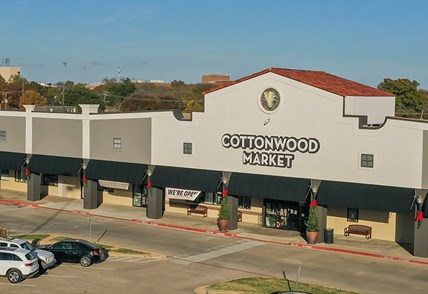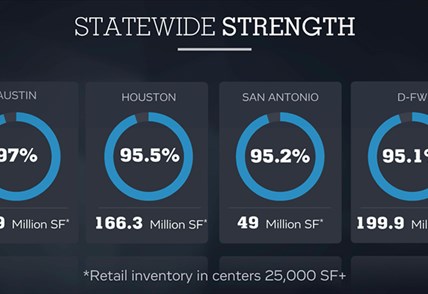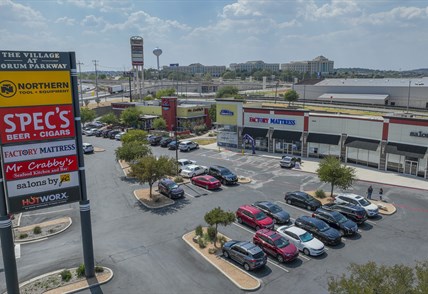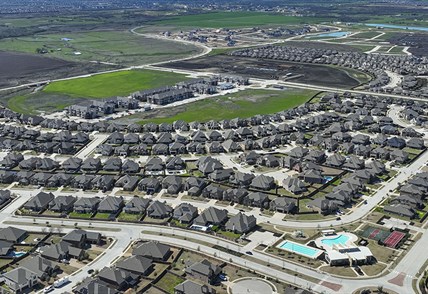By Marshall Mills, President & CEO
Texas houses four of the nation’s leading metropolitan areas within its borders, and these four markets – Dallas-Fort Worth, Austin, Houston and San Antonio – differ from each other in terms of their leading industries, their cultures and their histories.
But right now, all four share one trend in common: Strong retail markets reporting a return to pre-pandemic occupancy and leasing following a 2020 marked by chain failures and higher vacancy rates.
The downturn in 2020 occurred due to the COVID pandemic, and the improvements seen in 2021 resulted from an industry learning how to successfully navigate the challenges of a pandemic that continues in waves.
The retail industry innovated and evolved to face the new challenges with a focus on what we call Tech + Mortar – whereby concepts communicate with and fulfill customer needs with services like takeout, delivery, curbside and buy-online-pick-up-in-store (BOPUS). Customers embraced these changes, sales posted strong increases and, as a result, we saw retail demand in all of our markets recover in 2021,
As we start 2022, we’re in the midst of another pandemic wave because of the omicron variant. And while risks remain at multiple levels, we are armed with more tools and more knowledge about how to navigate our lives and how to shop and dine safely. And shopping centers, retailers and restaurants continue to do their part to make that happen.
MARKET AT A GLANCE: DALLAS-FORT WORTH
During 2021, strong retail leasing demand not only boosted Dallas-Fort Worth’s occupancy, it also significantly decreased the huge increase in vacant space that occurred during the worst of the pandemic in 2020.
At year-end 2021, D-FW reported an occupancy rate of 93.5 percent, which represents the third-highest occupancy for the market that Weitzman has ever recorded since its first Survey in 1990.
In fact, 2021 is only the 12th time in 32 years that D-FW has reported occupancy that exceeded the 90 percent rate.
The recovery is most evident in absorption, the measure of net leasing. During 2021, absorption totaled approximately 3.9 million square feet, the strongest leasing market for D-FW since 2015 and the third-strongest leasing market in 22 years.
During the worst of the pandemic in 2020, the market was hit by closings that resulted in a huge increase of more than 4 million square feet of new vacancy during the year.
The market also benefitted from the backfilling of anchor vacancies and an extremely conservative development climate that limited the overhang of vacant space.
CONSTRUCTION
During 2021, retail deliveries totaled only about 639,000 square feet, the first time in more than three decades that D-FW has seen construction below the 1-million-square-foot market.
D-FW’s limited space deliveries reflect the nationwide and statewide trend of anchor contractions and limited anchor expansions, existing project redevelopments for new tenancy, and smaller mixed-use and unanchored retail projects. In addition, many projects were delayed during the worst of the pandemic in 2020, and the delay meant that some 2021 projects will now open in 2022 and beyond.
Construction is expected to increase significantly during 2022 as large-format anchor H-E-B begins its marketwide expansion with its first D-FW stores, and anchors including Kroger get underway with new stores in markets like Melissa and Central Dallas.
MARKET AT A GLANCE: AUSTIN
Austin’s retail market at year-end 2021 reported a recovery in leasing demand that backfilled many of the market’s existing vacancies and helped return overall occupancy to 96.0 percent. The current occupancy rate represents a return to the pre-pandemic rate of year-end 2019.
During the worst of the pandemic in 2020, a number of retail closures resulted in an approximately 1.5-percent drop in occupancy, or about 770,000 square feet of newly vacant space.
The market’s occupancy stabilized thanks to the overall tight market for retail space, a recovery in leasing activity that is helping absorb well-located vacancies and extremely limited construction that comes online significantly or fully leased. The market additionally for 2021 did not experience the level of large-format store closings that occurred in 2020.
Even with a healthy retail market and strong economy, Austin recorded another year of extremely limited construction during 2021. Deliveries, however, slightly outpaced the 2020 level.
For 2021, Austin’s metro-area retail market added approximately 412,000 square feet of retail space in new and expanded projects each totaling 25,000 square feet or more.
New space deliveries have not reached the 1-million-square-foot threshold since 2016.
MARKET AT A GLANCE: HOUSTON
Houston’s retail market saw overall occupancy recover to its pre-pandemic rate of 95.0 percent as of year-end 2021, reversing a pandemic-induced occupancy decline of 2 percent during 2020.
Retailers leasing in existing space added vibrancy and cross-shopping to centers throughout the market, and these new leases are a big reason that market occupancy has stabilized. The Greater Houston retail market also reported limited large-format closings, unlike 2020 when anchor and junior anchor closings added 3.1 million square feet of new vacancy.
In terms of leasing, the restaurant market created a high level of demand, particularly for second-generation space. Larger-format concepts also expanded via existing space, helping erase some of the largest vacancies from the market.
Houston’s trend of limited construction continued in 2021 following calendar-year 2020 when new retail space deliveries established a new record low.
Until 2020, based on the more than three decades that Weitzman has reviewed the market, Houston had never before seen deliveries of new space dip below 700,000 square feet.
For calendar-year 2021, Houston saw deliveries of approximately 615,000 square feet of new retail space in new and expanded projects with 25,000 square feet or more. That total is lower than the previous record, set in 2020, when Weitzman showed the Houston-area retail market added only 695,200 square feet in retail projects of 25,000 square feet or more.
For 2022, however, new deliveries will increase significantly due to new and expanded retail projects that have been in the works for years, along with new stores from anchors like H-E-B, Target and Burlington.
MARKET AT A GLANCE: SAN ANTONIO
San Antonio’s retail market as of year-end 2021 saw occupancy reach 94.0 percent, a rate that compares favorably to the pre-pandemic occupancy of 94.5 percent reported at year-end 2019.
The market’s higher occupancy reflects steady demand for existing small-shop retail space from concepts ranging from restaurants to medical, beauty and boutique fitness. The past year also reported leasing that absorbed some of the market’s larger vacancies, such as a vacant department store that was backfilled by a discount concept.
During calendar-year 2021, San Antonio reported a decline for annual retail construction of new and expanded space. Construction has declined each year since 2018, when new space totaled 868,400 square feet.
For the year, Weitzman reports approximately 354,000 square feet of retail space in new and expanded projects.
For 2022, new projects coming online include a Floor & Décor anchor at IKEA-anchored Live Oak Town Center, as well as new community and neighborhood space.
This article originally ran in D CEO.




